
Continental drift was proposed by the German Alfred Wegener in 1912.
Continental drift is a theory that explains how continental masses move constantly and gradually, moving closer or further apart . The German Alfred Wegener was the one who proposed this hypothesis in 1912 .
Wegener observed the shapes of today's continents , examined fossils, and analyzed geological formations. His studies allowed him to infer that, in a distant period , the different continents were united and formed a single supercontinent, known as Pangea .
Continental drift, according to Wegener , is produced by the movement of continents across the ocean floor. The theory of the German geophysicist and meteorologist was expanded and improved decades later by the so-called plate tectonics .
Background of continental drift
The antecedents of continental drift date back several centuries before Wegener 's postulates. Already at the end of the 16th century , the Flemish Abraham Ortelius noticed the apparent articulation between the coasts located on both sides of the Atlantic Ocean . In this framework he indicated that America could have been separated from Africa and Europe through floods and earthquakes.
Other scientists such as Francis Bacon ( 17th century ), Alexander von Humboldt ( 19th century ) and Roberto Mantovani (late 19th century and early 20th century ) made assessments along the same lines. Many thinkers considered that the continents, at some point, were united or at least communicated, although they could not explain precisely how the separation could have occurred.
Wegener's contribution
Wegener 's contribution to these propositions was to consider that the continents moved slowly and continuously, moving over the layer of the Earth made up of the ocean floor.
Wegener stated that this layer even extended beneath the ocean floors. Thus, the continental masses moved in a similar way to what happens with the displacement of elements located on a sliding carpet.
In his theoretical development, Wegener was the one who named Pangea the supercontinent that would have emerged about 335 million years ago and began to fracture approximately 175 million years ago. Pangea erupted through the union of the existing continental masses at the end of the Paleozoic era and then dispersed to give birth, over time, to the current continents within the framework of the process explained by continental drift.
It is worth noting that, initially, the division of Pangea caused the emergence of two large continental masses: Laurasia and Gondwana , both separated by the Tethys Ocean (also known as the Tethys Sea ).

According to continental drift, continental masses are in a gradual and constant displacement.
Evidence of continental drift
The evidence of continental drift that Wegener found was various. The most notable is the coincidence that can be seen on any map regarding the shapes of the continents.
On the other hand, fossil remains of the same species of animals and plants have been found in the coastal areas of continents that are currently far away. This means that, in ancient times, the continental masses must have been united.
Likewise, it was proven that there are mountain formations that have the same type of stones and the same age on continental surfaces that are separated today. This is another indication considered by Wegener to maintain that the continents were united and then moved apart due to, according to his theory, the phenomenon of continental drift.
plate tectonics
Plate tectonics is the theory that, developed in the 1960s based on the contributions of various scientists, collected the ideas of continental drift. There is currently a broad scientific consensus on its validity.
According to plate tectonics , the Earth's surface is made up of tectonic plates that slide on the Earth's mantle. With this sliding of plates, the existence of a movement is maintained, as indicated by Wegener 's continental drift.
It is important to note that the solid, superficial layer of the Earth is called the lithosphere (or lithosphere ). It is made up of the crust and the outermost sector of the mantle and is balanced on the asthenosphere. Tectonic plates are the various fragments that make up the lithosphere and that host, on their edges, different geological phenomena (such as orogenesis and seismicity ).
What plate tectonics does is indicate how the structuring of the lithosphere occurs. The theory refers to the movement of plates to explain why each oceanic trench is located in an area close to a continent or an island and why earthquakes occur in specific sectors of the planet.

Continental drift states that the current continents are the result of the breakup of a supercontinent called Pangea.
Continental drift and ocean floor spreading
In his theory of continental drift, Wegener argued that continental masses moved through the sea. In the '60s , however, Harry Hess proposed a different view that is currently accepted by science: the expansion of the ocean floor , which is integrated into the theoretical framework of plate tectonics.
According to Hess , the formation of new oceanic crust (the area of the Earth's crust that makes up the oceans) takes place at the oceanic ridges (submarine ridges) thanks to volcanic activity and the gradual moving away of the bottom from the ridge.
This means that, with the movement of the ocean floor, the continents also move. The origin of the phenomenon lies in the convection currents that are generated in the asthenosphere .
In other words, the accumulation of matter in the mantle, coming from each oceanic ridge, drives the movement of the tectonic plate. For balance to be preserved, the rising material that creates new lithosphere must be compensated by the disappearance of an equivalent amount of lithosphere in another region, which occurs in the subduction zone that begins at the convergence of plates and ends where the Oceanic lithosphere ends up being absorbed by the mantle.
